SimonMoon here to talk about Aggro Runner decks in Netrunner. First a little gh-story about myself. I started playing Netrunner competitively around when Upstalk came out, and at that point I had just a core set. After going to a meetup or two and getting crushed, I looked up what decks were successful back then in the Stimhack archives (great resource) and modified a Gabe deck given my limitations. I instantly fell in love with his aggressive style that put heavy pressure on the corp, and played him up until Order and Chaos. At that point, I switched over to playing an aggro Maxx deck that I built myself that I have been mildly successful with, winning Stimhack League 3, and a Store Championship, and placing top 8 at Philly regionals.
The name “Aggro” for this style of decks comes from Magic the Gathering, and in Magic aggro decks seeks to overwhelm the opponent in the early game and win before their opponent can set up and win in the late game. While I think this is a useful starting point, I don’t think it entirely applies to Netrunner. Probably the biggest difference is that Netrunner, as an asymmetrical game, has a natural power curve for each side. This has traditionally been thought of in three stages: the early game where the corp doesn’t have enough ice and money to protect all servers, the mid game where the runner doesn’t have the necessary breakers to get into every server, and the late game where the runner has a full rig built and can get into every server. The runner has a natural advantage in the early game and late game, while the corp has an advantage in the mid game. Aggro decks in Magic seek to win in the early game, but that isn’t really how aggro decks work in Netrunner.
The biggest difference is that the no matter how good they make them, the runner cannot get enough accesses to consistently win in the early game. There is also the fact that they can’t face a mirror aggro matchup as Corp aggro (or rush) decks work very differently from runner decks. In fact, aggro runner decks really work by seeking to do two things:
- Dominate the early game
- Control the corps development so that the game stays in the early game.
The second point I think is a very key concept to understanding decks in Netrunner, that decks aren’t just trying to have better late games or early games, but are also trying to have longer late games or shorter mid games. For example, a big rig deck might sacrifice their early game advantage in order to shorten the mid game and jump straight to the end game where they have both natural advantage that they’ve built their deck to make even stronger. A corp rush deck seeks to push the game into the mid game as fast as possible at the expense of the corp’s late game. The large variety of ways in which decks to shape these natural power curves is what I find most interesting about Netrunner as a game. Now, onto the two core goals of Aggro decks.
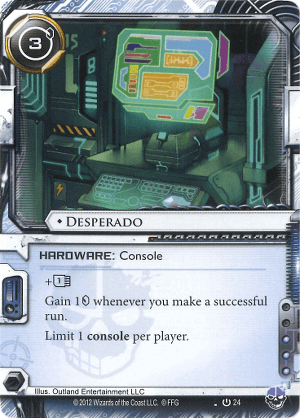
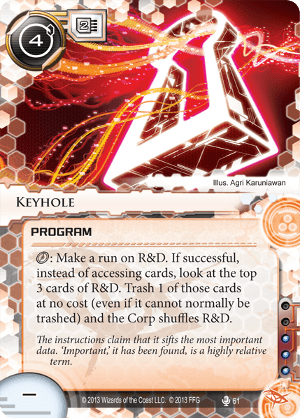
Goal 1: Dominate the Early Game
The early game is defined by free or cheap runs as the corp doesn’t have sufficient resources (ice/money) to defend all their servers. To take advantage of the early game you want to have cards that work well with a plethora of easy runs. These can either be cards that let you turn lots of successful runs into lots of accesses (medium/keyhole) or cards that give you benefits for making guaranteed successful runs (desperado/datasucker/dirty laundry). Aggro deck also want the ability to set up quickly and feel able to run without needing a bunch of cards or a large expensive rig. You don’t want to be weighed down clicking for credits and cards, you want to be slamming into servers and getting free accesses + benefits from these easy early game runs.
To apply this pressure, you need to be able to facecheck ice, as you need to be figuring out what servers you can run for free as well as forcing the corp to put their resources into rezzing ice. Aggro decks generally can’t afford to let a corp get by with an R&D or HQ with unrezzed ice that they don’t run because they’re afraid it’s a Komainu or Grim or whatever. They need to be able to run wherever and figure out where they can get their easy accesses on and put pressure on the corp to rez their ice.
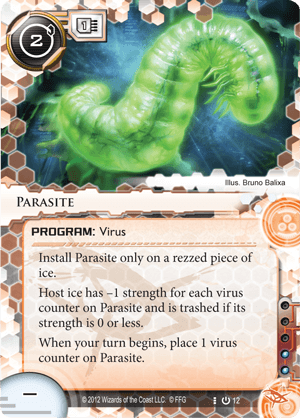
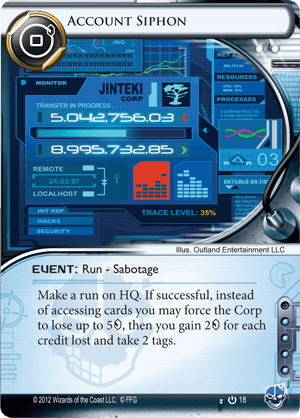
Goal 2: Extend the early game
Secondly, in order for your ability to win with an aggro deck you need the early game to last longer than normal. The two primary methods of doing this are econ denial and ice denial. You either want them to have no money to rez their ice, or not have ice to rez. Siphon is the biggest tool of the former method, while parasite the biggest of the latter. Its important to note these aren’t exclusive, and ice denial feeds into the second as ice is expensive to rez and destroying it is like destroying that much money of the corps. Additionally, when the runner destroys ice, the corp is often forced to use more expensive ice or off position ice, as you’re generally destroying their best early game ice. Another key aspect of extending the early game is to have good multi-central pressure (archives especially, as this server doesn’t naturally need defending). When you force them to spread their ice between 3 rather than 2 or even 1 central server, they need to have a lot more resources committed to defending them, which means you’re in the early game longer.
Now, I’ll break down how a couple of different aggro decks implement these two goals.
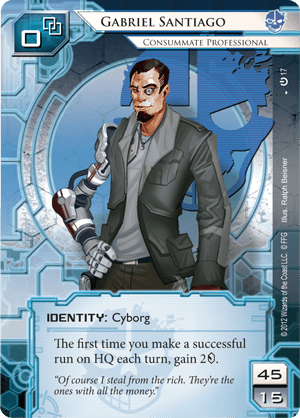
Gabe
Gabriel Santiago: Consummate Professional
Event (20)
3 Account Siphon
2 Dirty Laundry
3 Emergency Shutdown
1 Indexing
2 Inside Job
1 Planned Assault
2 Quality Time
3 Special Order
3 Sure Gamble
Hardware (6)
3 Desperado
1 HQ Interface
2 Plascrete Carapace
Resource (4)
2 Bank Job
2 Same Old Thing
Icebreaker (8)
1 Corroder
3 Faerie
1 Femme Fatale
1 Mimic
1 Passport
1 Yog.0
Program (7)
2 Datasucker
2 Parasite
3 Sneakdoor Beta
Gabe is the oldest aggro ID, and the ID I started running with. His ability lets him gain advantages of easy HQ runs giving him econ without any setup. Desperado and Datasucker make every run profitable, and Faerie lets him facecheck with impunity. Special order gives him the ability to get the one or so breaker that he needs out early to continue applying pressure. Account Siphon and Emergency Shutdown provide very strong econ denial, and he often plays Parasite, which provides some amount of ice destruction (usually key ice he can’t break which allows him to need less breakers in the early game, and spend more time getting free runs). HQ is threatened through his ability, Siphon, and Desperado and is usually his number one threat server. Sneakdoor provides very strong archives pressure, almost as strong as HQ. R&D gets pressured through Desperado and Datasucker, and Indexing is the strongest R&D event you can play when you’re getting free R&D runs. Gabe is strong and especially with a good Desperado start can snowball the game in a way that the opponent feels they never had a chance.
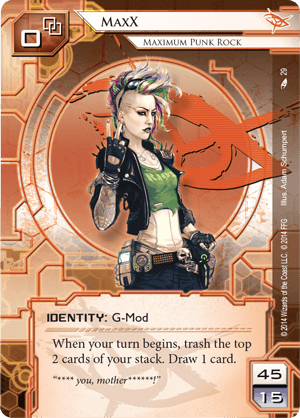
Eater Siphon Maxx
MaxX: Maximum Punk Rock
Event (27)
2 Account Siphon
3 Day Job
3 Deja Vu
1 Forked
2 Inject
3 I’ve Had Worse
2 Knifed
1 Levy AR Lab Access
2 Retrieval Run
1 Singularity
2 Spooned
3 Sure Gamble
2 Wanton Destruction
Hardware (1)
1 BOX-E
Resource (7)
1 Hades Shard
3 Liberated Account
3 Same Old Thing
Icebreaker (8)
3 Eater
2 Femme Fatale
3 Knight
Program (2)
2 Keyhole
Eater Siphon Maxx showed up on the scene pretty much as soon as Order and Chaos came out. Using eater the primary and often only breaker, Siphon Maxx sets up very quick and can facecheck with relative impunity. Maxx’s ability quickly finds you the pieces you need to set up, so its rare that Siphon Maxx goes very long without getting the pieces it needs. Keyhole is devastating on an undefended R&D, and will extremely quickly win the game if left undefended. Siphon is in the name, as it provides extremely strong econ denial, especially with Same Old Thing and Deja Vu acting as copies 4-9. Since Eater can get through anything, each Siphon provides the econ needed to land the next one as well as money to Keyhole R&D if they have one or so ice up. Either cutlery or Parasite support provide ice denial as well as further damaging the corp’s econ and board position. All the servers are pressured, with HQ being the number one threat, as Account Siphon can single handedly keep the corp poor and useless. As stated earlier, R&D cannot be left undefended against Keyhole, as it will very quickly end the game. Eater Siphon Maxx is strong but is pretty vulnerable to a couple of hate cards that see play such as Crisium Grid, Wraparound, and Caprice Nisei as well as the general Siphon vulnerability to high rez cost assets and upgrades.
Parasite Spam Maxx
MaxX: Maximum Punk Rock
Event (22)
3 Deja Vu
3 Dirty Laundry
3 Inject
3 I’ve Had Worse
1 Knifed
1 Levy AR Lab Access
2 Lucky Find
1 Queen’s Gambit
1 Retrieval Run
1 Spooned
3 Sure Gamble
Hardware (5)
3 Clone Chip
1 Grimoire
1 Net-Ready Eyes
Resource (6)
2 Daily Casts
2 Same Old Thing
2 Scrubber
Icebreaker (3)
1 Corroder
1 Mimic
1 Yog.0
Program (12)
2 D4v1d
3 Datasucker
2 Imp
2 Medium
3 Parasite
Parasite Spam Maxx is the deck I’ve been build working with and using since Order and Chaos came out. While it may look very similar to minimum punk rock (Regass) Maxx, don’t be fooled; this Maxx is all Bikini Kill. You want to get out a Datasucker quickly and then get easy runs which give you sucker tokens needed to Parasite all the ice for more easy runs and more virus counters. Maxx’s milling combined with Deja Vu and Clone Chip lets Datasucker come out very fast very consistently. Clone Chip Parasite helps you facecheck, though the amount of recursion as well as I’ve Had Worse means bad sentries often aren’t that big of deal. Medium provides the strongest undefended R&D pressure in the game, and once you run an undefended R&D for 4 Medium counters and 4 Datasucker counters, it’s hard for your opponent to recover as instant Parasite will take care of whatever ice is used to stop the hemorrhaging. Parasite Maxx doesn’t directly pressure the opponent’s econ in the same way as the other two builds, but rather focuses on denying ice through repeated Parasite recursion (as well as D4vid + knifey spooney for the big ice). R&D is the main focus, with giant medium being the typical win condition. However, building sucker counters while getting accesses is pretty big against HQ, and archives needs to be defended or Datasucker builds up into giant stacks of instant destruction. I’ve had a ton of success with this build, winning SHL3 and a Store Championship with it, and its deck that is simply a blast to play.
Pressure
One of the key components of all these decks is that they present threats that have to be answered immediately. You cannot let Gabe get free HQ runs for every long and expect to win. You cannot let Medium and Datasucker get built up. You cannot let Eater Maxx get the Siphon lock started. Forcing the corp to spread their resources across multiple servers helps weaken the corps defense against these threats, as they have to spread their resources uncomfortably thin. This also means they have often must use non-ideal ice to protect servers which weakens their game. Additionally, by forcing them to have to answer your threats, you often force them to draw to find answers, which is GREAT for aggro decks. As the corp is drawing, more agendas enter the game, giving the agro deck more points to score on any free HQ accesses that you’re deriving benefit from anyway (or for Siphon Maxx, Wanton Destruction lets you get the accumulated Agendas out of HQ). Additionally, when the corp has to draw for cards (or click for credits when they don’t have money), agenda’s build up in their hand and force them to discard cards that would otherwise have been useful for them.
With these agendas they have building up their hand, you need to keep them there so your easy HQ accesses turn into points. This is where pressure comes into play; often times the best way to keep them from scoring is not to actually go in and score, but force them to commit too many resources to score to prevent you from making a strong central counter attack. I win games vs. Astrobiotics all the time when my opponent goes broke or close to it to score an astro off a Sansan, and I simply drop a medium and start plowing into R&D without bothering to trash the Sansan. All these decks also provide ways to contest against lightly defended remotes (Inside Job, Parasite, Siphon), which means scoring early against them means committing multiple ice (which is now not defending centrals) or in Eater Maxx’s case, the corp simply can’t score when Eater Maxx can siphon you and walk into the remote for free.
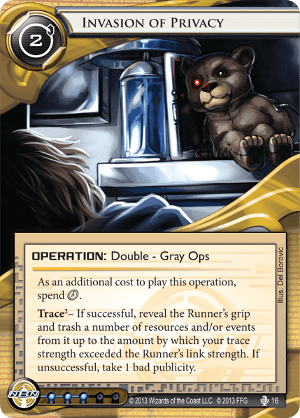
Information
One of the more underappreciated aspects of Netrunner in general is that even non-agenda accesses give you valuable information. Aggro decks in general get you lots of accesses, and on lots of these you won’t steal or trash the card(s) you see. However, these accesses still give you a tremendous amount of value. Knowing your opponent has a Restructure in hand can give you the knowledge your opponent really doesn’t want to rez their ice. More often, however, what you get is knowledge of what ice your opponent has in their hand. If you see an Archer, you know you need to be careful or prevent them from scoring. Any piece of big ice, and you can know your opponent will be hesitant to rez it, so dropping a Medium and forcing the rez might be a good play. This is especially true when you’ve been applying pressure well and you know they would have played any ice you have, so when you see a piece of ice on the top of R&D and they play one next turn you know what that is.
The information edge can get really complicated, and sometimes when you’ve seen 3-4 cards out of your opponent’s hand it’s possible to deconstruct their play to figure out what else they’re holding onto and what their entire turn or last two turns of play has been. You can also manipulate where you apply pressure to get them to rez non-ideal ice allowing you to get into the server you really want, or to time ice destruction so they place the Architect they just drew onto archives instead of R&D. This is one of the big reasons I enjoy playing aggro decks: to really play them well you need to get really good at reading your opponents plays.
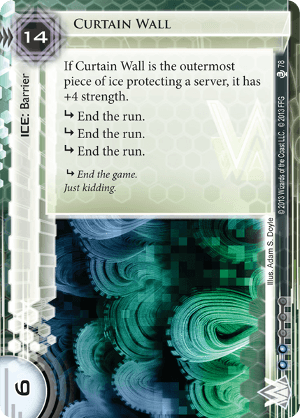
Late Game
Sometimes when you’re playing aggro deck the corp manages to stabilize and build up a board position and break out of the early game. Aggro decks usually aren’t designed around this stage of the game, but they normally have some outs and don’t just completely give up. Ideally if you go into the late game you want to be up 5-0 or 5-2. If you are, they can’t afford to give up any points and you can usually threaten the remote to prevent easy scores. Additionally, because they’ve often been Jacksoning their agenda’s back into R&D to keep them out of the game, (a key tactic basically every corp has to reduce their early game vulnerability against aggro), R&D is often extremely agenda-dense by the end of the game. Single glory run accesses become much better in these situations and give you an out if you can’t get in their remote. Your opponent getting to the late game is generally how you lose, and it’s important to note that aggro decks are pretty much always better at being early game decks than corp decks, so when playing against one your goal as a Corp should be to turtle up, even if that goes against your decks normal game plan.
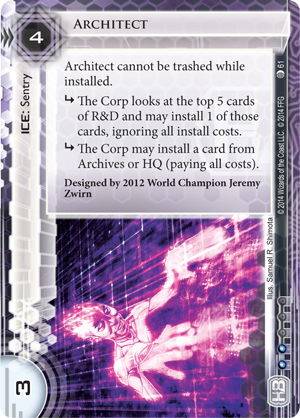
Aggro in Today’s Meta
Despite my own success with Aggro runner decks, I don’t think they’re terribly well-positioned in the current metagame. Corp decks continue to get better econ and better early game ice and it’s gotten harder and harder to keep them down. Architect in particular is indestructible and simply devastating to facecheck for a lot of aggro decks, but the grail ice as well as Cortex Lock have punished facechecking even harder and cheaper. In terms of identities, Blue Sun neuters Parasite and can recover very well from low credits (as well as being able to reposition ice to exactly where you’re attacking). Engineering the Future can rebuild their ice while gaining money, which is extremely strong vs. aggro decks. Both of these ID’s are the dominant ID’s in their respective factions.
Additionally, runner decks in general are very strong right now, and I feel that aggro decks tend to do better in a meta where runner decks are weaker. Since aggro needs to get out to a good fast start, there is an inherent lack of consistency to them that is not necessarily there for decks with longer game plans. The better a given side is “naturally”, the more I’m concerned with the consistency over power level, and right now the opportunity cost for playing an aggro deck given how strong Prepaid Kate or Regass Maxx are.
Finally, and I think that this is important, there is not a rock-paper-scissors situation going on between aggro decks, late game decks, and midrange decks the same way there is in Magic. Some aggro decks are good against RP (Parasite Maxx) while some aggro decks are bad against RP (Siphon Maxx, Gabe). Some aggro decks are relatively good against Fastrobiotics (Parasite Maxx/Gabe), while others are bad (Siphon Maxx). The decks aren’t uniformly good against glacier decks, or uniformly bad against rush decks, or any one particular sort of game-stage-based corp deck. How good aggro decks are against late-game or early game corp decks tends to depend on how vulnerable the given corp deck is to the aggro player’s form of parasite/ice denial, and not whether or not the game plan of the corp deck is to get to play a quick game or a long game.
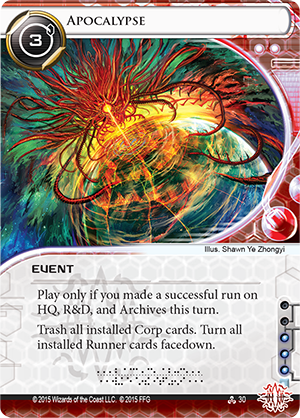
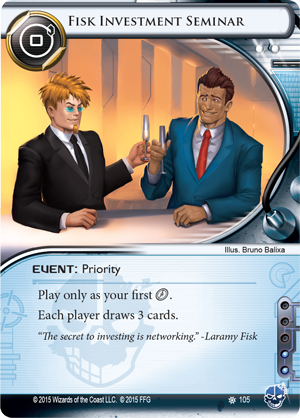
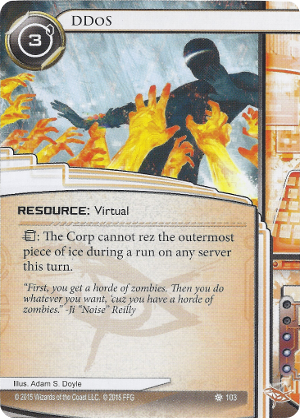
Aggro in the Future
I feel there is room to experiment with the existing card pool, as Lamprey is a card I’ve always felt had potential for an aggro deck but I’ve never been able to figure out how to use well. However, in general I feel like aggro decks are going to need new support in order to survive in the current meta of solid early game ice and good econ that is hard to shut down. Something that provides strong archives pressure from the start out of Anarch could push parasite Maxx to another level (if archives interface was 0-cost it could be pretty decent for this actually). There’s also potential for the design space to expand to allow for more cards that threaten cards in hand as a resource, but I don’t feel the existing cards (imp, wanton destruction, itinerant protesters) are really there to design a whole deck around aggressively attacking the corp’s cards in hand from the start.
There’s also a couple of upcoming cards that I think could be good for aggro runners. Fisk investment seminar could help out criminal aggro. It does a couple things: it provides much needed card draw for criminals while simultaneously forcing the corp to speed up their game (and put more points into it). If you force the corp to draw up to 9 and then siphon them down to zero there is huge potential for scoring points. Where as previously you siphon them to zero, access their hand a bunch and score the 2-pts of agendas in there. They click for 3 credits a couple of turns in a row and recover and you lose after they grind the game out because there simply weren’t enough points in the game.
Apocalypse has the ultimate board reset button, destroying everything but architect and restoring the game the start, which is an absolutely insane effect for aggro decks. It will be interesting to see if it can be built around. DDoS allows for guaranteed turn one Siphons, which seems like it could be very powerful out of Anatomy of an Anarch style siphon builds. (It has the secondary property of messing up your opponents siphon math when they try and reduce their credit pool to zero during your Siphon run to deny you the money, which is extremely important way to deal with Siphon in high level play). These are a couple of upcoming tools I’m looking forward to playing around with, but I’m not crazy about any of their ability to push aggro decks to the next level.
In Summary
Aggro decks exist on a really interesting part of the power curve in Netrunner, and I really enjoy playing them. The struggle to keep the corp down so you can get the accesses you need before they’re able to stabilize the board gives a sense of urgency to Netrunner that I really enjoy. So in summary, play aggro decks. They’re fun, interesting and you’ll learn something.




